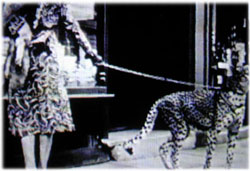| During
our studies into the Big Cats roaming free around
the UK the main questions that we are always asked
are:- |
 |
| How did they get there? |
| During
the stylish 1960's and 70's it was very
fashionable and perfectly legal in the UK to
keep exotic animals as household pets, these
ranged from leopards, pumas and panthers to
crocodiles and poisonous snakes.
Anybody
could legally own and keep them as pets,
take them out for walks and keep them in the
house without any kind of licence or any
special training. |
 |
|
 |
| In
1976 the Government introduced the Dangerous Wild
Animals Act to protect the public and ensure the
animals we're looked after properly. |
 |
| When the bill came into force exotic pet
owners we're only really faced with 3 choices. |
 |
 |
Get
a licence and improve the facilities for
looking after the animals incurring great
expense. |
 |
 |
 |
Give
their pet to a zoo or authorized keeper of
such animals. |
 |
 |
 |
Have
their pet put down. |
|
 |
| Many
owners gave their pets up to local zoos and
wildlife parks, but with the amount of animals
around the zoos and other establishments couldn't
cope with the numbers, so some we're unfortunately
put down. A minority of owners who couldn't
stand to see their pet put down, set them free to
fend for themselves in the wild and this is how
the majority of Big Cats got into the UK
countryside, obviously there is the possibility of
zoo and circus escapees but being released from
captivity is the most recognized source for most
of the Big Cats roaming the UK. |
 |
| Due to
a loop hole in the law, it was not illegal until
1981 to release a big cat into the UK
countryside! So many owners despite
introducing a new non-native species didn't
actually break the law, which does sound silly but
the law was slack, it still is in some ways.
A legal owner of a Big Cat in the UK does not by
law have to inform anyone if one of their animals
escapes or dies, nor do they have to inform the
Authorities if they breed in captivity, so the
exact number of Big Cats in this country is very
hard to say. |
 |
| How can they survive? |
| Quite
easily is the answer! People always say how
can they live in our climate, well they we're
living in cages in peoples gardens before they
we're released so they we're already prepared for
the weather, as for food, when hungry a Big Cats
natural hunting instinct would soon return and as
it has so often been reported sheep and other many
other livestock have been preyed upon, there are
also plenty of deer, rabbits and other natural
inhabitants in abundance in the UK for them to
prey upon. Remember we are not talking about
thousands and thousands of animals that are out
their, the exact number may never be known, but
there is plenty of food to sustain a small
population of Big Cats in the United Kingdom. |
 |
| Are they dangerous? |
| Reports
of attacks by wild big cats are very very rare in
the UK, the most publicized one being on Saturday
August 26th 2000, when 11 year old Josh Hopkins
was clawed across the face in Trelleck, South
Wales. Josh was attacked after he went to
pet the cat believing it to be his pet cat
Sylvester! The Cat was never found despite a
huge search so it is really difficult to say
whether it was a Big Cat or not. In London a
female European Lynx was caught in Cricklewood, North London on
Friday 4th May 2001 after being spotted in a back
garden, the Lynx which was injured was taken to
London Zoo and is almost definitely a recently
escaped pet that will never be claimed or
confirmed as such as the owner may not have had a
licence to keep it and so will never come forward. |
 |
| How come they aren't seen more often? |
| Big
Cat sightings in the UK do occur sometimes in
regular batches other times they are quite rare,
these cats had been kept in captivity against
their will and once granted freedom it is our
belief that they obviously do not want to be caged
up again and so whenever they sense our presence
they disappear off in the other direction.
This is a natural survival instinct and as we are
not talking about a huge population of wild big
cats the chances of them being seen are not that
great to begin with. |